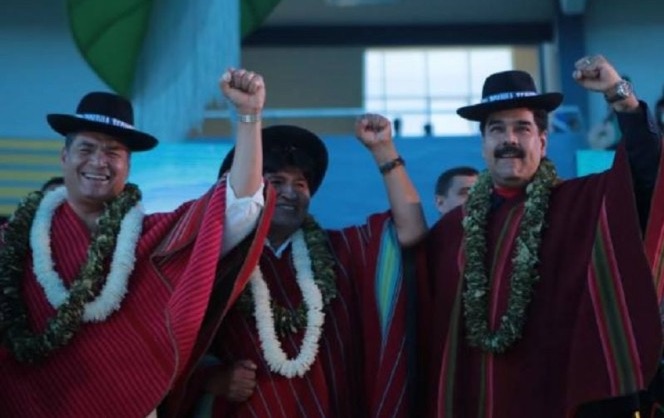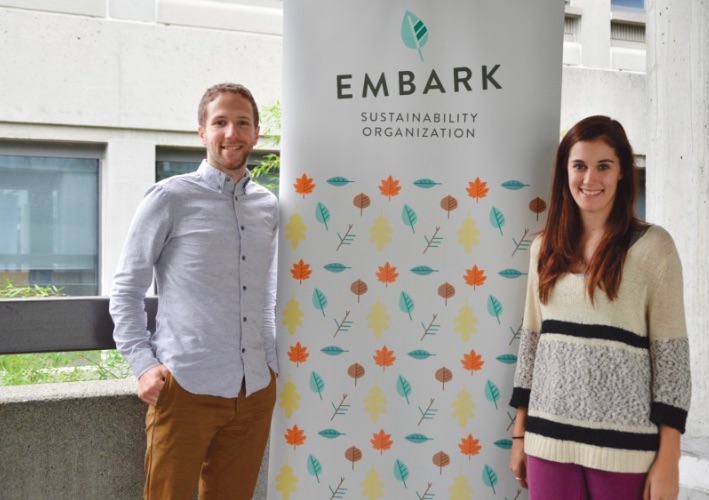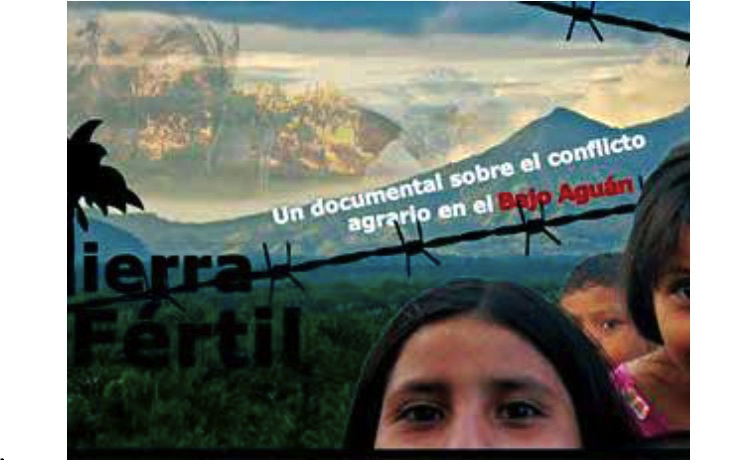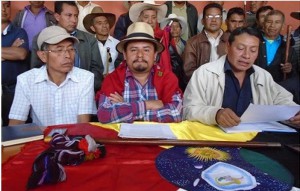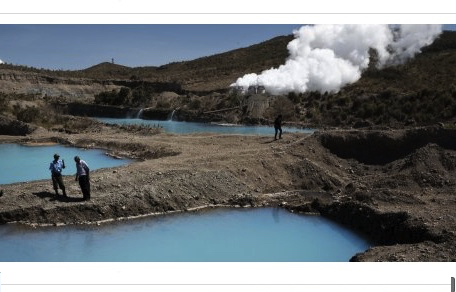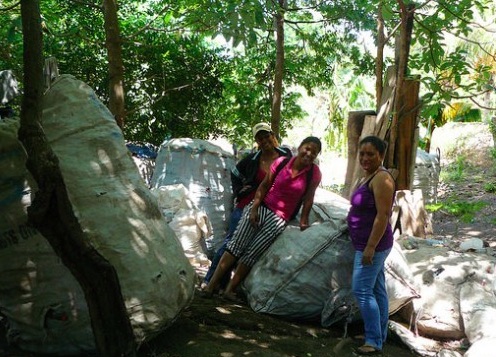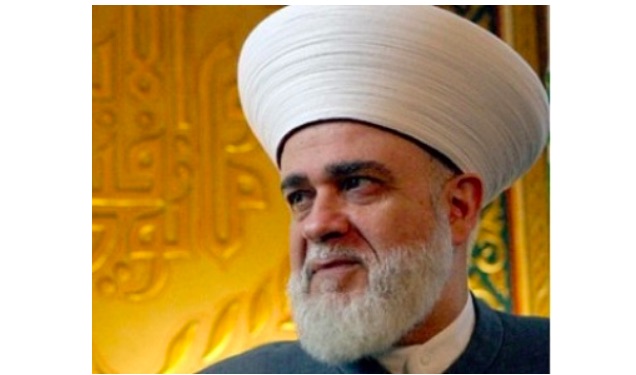. SUSTAINABLE DEVELOPMENT .
Marianela Jarroud, Inter Press Service News Agency (reprinted by permission)
Terrace farming as practiced from time immemorial by native peoples in the Andes mountains contributes to food security as a strategy of adaptation in an environment where the geography and other conditions make the production of nutritional foods a complex undertaking.
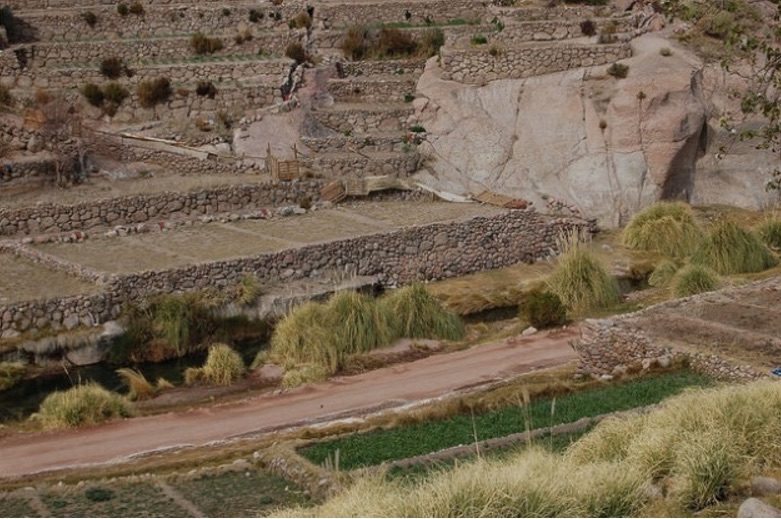
Terraces built by Atacameño Indians in the village of Caspana in Alto Loa, in the northern Chilean region of Antofagasta. This ageold farming technique represents an adaptation to the climate, and ensures the right to food of these Andes highlands people. Credit: Marianela Jarroud/IPS
Click on photo to enlarge
This ancient prehispanic technique, still practiced in vast areas of the Andes highlands, including Chile, “is very important from the point of view of adaptation to the climate and the ecosystem,” said Fabiola Aránguiz.
“By using terraces, water, which is increasingly scarce in the northern part of the country, is utilised in a more efficient manner,” Aránguiz, a junior professional officer on family farming with the United Nations Food and Agriculture Organisation (FAO), told IPS from the agency’s regional headquarters in Santiago, some 1,400 km south of the town of Caspana in Chile’s Atacama desert.
In this country’s Andes highands, terrace farming has mainly been practiced by the Atacameño and Quechua indigenous peoples, who have inhabited the Atacama desert in the north for around 9,000 years.
Principally living in oases, gorges and valleys of Alto Loa, in the region of Antofagasta, these peoples learned about terrace farming from the Inca, who taught them how to make the best use of scant water resources to grow food on the limited fertile land at such high altitudes.
The terraces are “like flowerbeds that have been made over the years, where the existing soil is removed and replaced by fertile soil brought in from elsewhere, in order to be able to grow food,” the Agriculture Ministry’s secretary in Antofagasta, Jaime Pinto, told IPS.
“This has made it possible for them to farm, because in these gorges where they terrace, microclimates are created that enable the cultivation of different crops,” Pinto, the highest level government representative in agriculture in the region, said from the regional capital, Antofagasta.
The official said that although water is scarce in this area, “it is of good quality, which makes it possible, in the case of the town of Caspana, to cite one example, to produce garlic or fruit like apricots or apples on a large scale.”
According to official figures, in the region of Antofagasta alone there are some 14 highlands communities who preserve the tradition of terrace farming, which contributes to local food security as well as the generation of income, improving the quality of life.
Communiities like Caspana, population 400, and the nearby Río Grande, with around 100 inhabitants, depend on agriculture, and thanks to terrace farming they not only feed their families but grow surplus crops for sale.
But people in other villages and towns in Alto Loa, like Toconce, with a population of about 100, are basically subsistence farmers, despite abundant terraces and fertile land. The reason for this is the heavy rural migration to cities, which has left the land without people to farm it, Pinto explained.
(Article continued in right column)
Question for this article
Indigenous peoples, Are they the true guardians of nature?
(Article continued from left column)
“Ours is fertile land,” Liliana Terán, a 45-year-old mother of four and grandmother of four who belongs to the Atacameño indigenous community, told IPS. One of her income-generating activities is farming on the small terrace she inherited from her mother in Caspana.
“Whatever you plant here, grows,” she added proudly.
The name of her indigenous village, Caspana, means “children of the valley” in the Kunza tongue, which died out in the late 19th century. The village is located 3,300 metres above sea level in a low-lying part of the valley.
Caspana is “a village of farmers and shepherds” reads a sign carved into stone at the entrance to the village, which is inhabited by Atacameño or Kunza Indians, who today live in northwest Argentina and northern Chile.
Each family here has their terrace, which they carefully maintain and use for growing crops. The land is handed down from generation to generation.
Each village has a “juez del agua”, the official responsible for supplying or cutting off the supply of water, to ensure equitable distribution to the entire village.
“The water flows down through vertical waterways between the terraces, from the highest point of the river, and is distributed in a controlled mmaner,” said Aránguiz.
“With this system, better use is made of both irrigation and rainwater, and more water is retained, meaning more moisture in the soil, which helps ease things in the dry periods,” she added. “And the drainage of water is improved, to avoid erosion and protect the soil.”
All of these aspects, said the FAO representative, make terrace farming an efficient system for fighting the effects of climate change.
“Well-built and well-maintained terraces can improve the stability of the slopes, preventing mudslides during extreme rain events,” she said, stressing “the cultural importance of this ancestral technique, which strengthens the economic and social dynamics of family agriculture.”
Aránguiz pointed out that indigenous people in the Andes highlands have kept alive till today this tradition which bolsters food security. She specifically mentioned countries like Bolivia and Peru, noting that terrace farming is used in the latter on more than 500,000 hectares of land.
Luisa Terán, 43, who has an adopted daughter and is Liliana’s cousin, works the land on her mother’s terrace.
When IPS was in the village the day before the traditional ceremony when the local farmers come together to clean the waterways that irrígate the terraces, Luisa was hard at work making empanadas or stuffed pastries for the celebration.
“This ceremony is very important for us,” as it marks the preparation of the land for the next harvest, she said.
Pinto underlined that “maintaining these cultivation systems is a responsibility that we have, as government.”
He said that through the government’s Institute of Agricultural Development, the aim is to implement a programme for the recovery and maintenance of terraces that were damaged in the most recent heavy storms in northern Chile.
In addition, projects are being designed “to help young people see agricultural development as an economic alternative.”
This goes hand in hand with the fight against inequality, Pinto said.
“We are working on creating the conditions for food autonomy and it is this kind of cultivation that can generate contributions to agricultural production to feed the region,” he added.
Edited by Estrella Gutiérrez/Translated by Stephanie Wildes
(Thank you to Janet Hudgins, the CPNN reporter for this article.)
